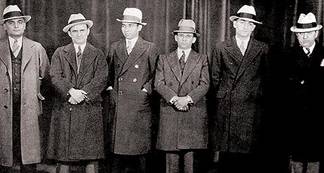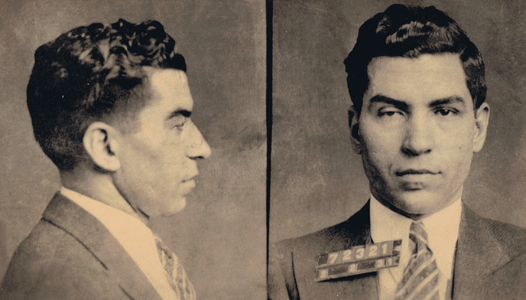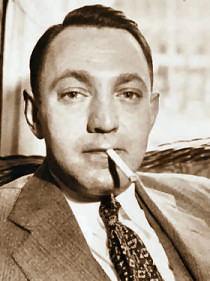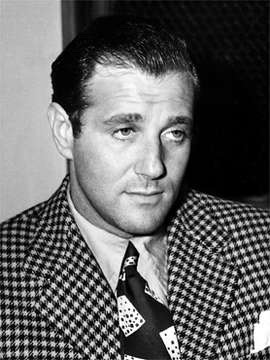


Movies and The Mob: part 2
 | |
| 1932 police line up (left to right) : Paul "The Waiter" Ricca, Sylvester Agoglia,Charles "Lucky" Luciano, Meyer Lansky, John Senna, Harry Brown | |
 | |
| Arnold Rothstein | |
 | |
| Charles "Lucky" Luciano | |
 | |
| Arthur "Dutch Schultz" Flegenhiemer aka The Beer Baron of the Bronx | |
 | |
| Ellsworth "Bumpy" Johnson | |
 | |
| Benjamin "Bugsy" Siegel | |
 The Gangster Wars: The best movie about Lucky Luciano and the New York mob in the 1920's and 30's. Covers everything from Arnold Rothstein's murder, the Castallamerese Wars, to the hit of Dutch Schultz. This is a movie edited in two-parts that combines the major scenarios of the TV series The Gangster Chronicles. Although Meyer Lansky was renamed Michael Lasker in this because he was still alive when it came out it still stays amazing close to real life incidents. It strays somewhat by adding a love interest that was with Capone, then Luciano, and then Dutch Schultz. Pretty much perfect if you want to see the basics of what went on in the New York mob in the 1920's. It ends with Luciano going to jail, Meyer taking off for Cuba, and Bugsy embarking for Las Vegas.
The Gangster Wars: The best movie about Lucky Luciano and the New York mob in the 1920's and 30's. Covers everything from Arnold Rothstein's murder, the Castallamerese Wars, to the hit of Dutch Schultz. This is a movie edited in two-parts that combines the major scenarios of the TV series The Gangster Chronicles. Although Meyer Lansky was renamed Michael Lasker in this because he was still alive when it came out it still stays amazing close to real life incidents. It strays somewhat by adding a love interest that was with Capone, then Luciano, and then Dutch Schultz. Pretty much perfect if you want to see the basics of what went on in the New York mob in the 1920's. It ends with Luciano going to jail, Meyer taking off for Cuba, and Bugsy embarking for Las Vegas. Hoodlum: Pretty much the only film about black gangsters worth watching, as American Gangster failed on all levels including its usage of black mob boss Bumpy Johnson who is the center of this far superior film. Hoodlum covers the era when Dutch Schultz was at war with the black mob ran by Madame St.Claire and Bumpy Johnson for control of the numbers policy. Lawrence Fishbourne turns in one of his better performances as Ellsworth "Bumpy" Johnson. Andy Garcia's Luciano is a failure as it makes him a pimp which in real life was most likely a fabrication to have a reason to send him to jail. The period clothing, the jazz music, the Cotton Club and the look at 1930's Harlem all are highlights of the film but the showstopper and scene stealer is Tim Roth as Dutch Schultz. Roth ( and to the same extent Jonathan Banks in The Gangster Wars) as the foul mouthed, racist, thrift store suit wearing, cold blooded murdering Schultz is the most fully realized portrayal of the gangster yet. There are countless memorable quotes from him and all are most politically incorrect. That's one of the more commendable things that can be said of this film is that it pulls no punches. While it adds some embellishments regarding Bumpy's involvement in dealings with Luciano, and it sort of gets the Dutchman's murder wrong, it never the less is the most underrated of all gangster films.
Hoodlum: Pretty much the only film about black gangsters worth watching, as American Gangster failed on all levels including its usage of black mob boss Bumpy Johnson who is the center of this far superior film. Hoodlum covers the era when Dutch Schultz was at war with the black mob ran by Madame St.Claire and Bumpy Johnson for control of the numbers policy. Lawrence Fishbourne turns in one of his better performances as Ellsworth "Bumpy" Johnson. Andy Garcia's Luciano is a failure as it makes him a pimp which in real life was most likely a fabrication to have a reason to send him to jail. The period clothing, the jazz music, the Cotton Club and the look at 1930's Harlem all are highlights of the film but the showstopper and scene stealer is Tim Roth as Dutch Schultz. Roth ( and to the same extent Jonathan Banks in The Gangster Wars) as the foul mouthed, racist, thrift store suit wearing, cold blooded murdering Schultz is the most fully realized portrayal of the gangster yet. There are countless memorable quotes from him and all are most politically incorrect. That's one of the more commendable things that can be said of this film is that it pulls no punches. While it adds some embellishments regarding Bumpy's involvement in dealings with Luciano, and it sort of gets the Dutchman's murder wrong, it never the less is the most underrated of all gangster films. Murder Inc.: This film continues the New York mob saga into the 1940's with the end of Kid Twist Reles and Lepke Bulchalter's hit men ring. Peter Falk is pure gold here. Forget Columbo, Falk was Pesci before there was Pesci. One of the most frighteningly brutal performances I have seen. Way ahead of his time. Lepke is played here oddly almost reptilian some have said. He is played by stage actor David J. Stewart and is one of the most fascinating screen gangsters in movie history. Wether Lepke was like this or not I doubt it but it makes for good entertainment. The film is based on the "true life" account written by the prosecutor himself Burton Turkus.
Murder Inc.: This film continues the New York mob saga into the 1940's with the end of Kid Twist Reles and Lepke Bulchalter's hit men ring. Peter Falk is pure gold here. Forget Columbo, Falk was Pesci before there was Pesci. One of the most frighteningly brutal performances I have seen. Way ahead of his time. Lepke is played here oddly almost reptilian some have said. He is played by stage actor David J. Stewart and is one of the most fascinating screen gangsters in movie history. Wether Lepke was like this or not I doubt it but it makes for good entertainment. The film is based on the "true life" account written by the prosecutor himself Burton Turkus. Bugsy:This is the story of Bugsy Siegel's and the mobs creation of Las Vegas and his murder. It takes place just after Murder Inc was disbanded and during the time Luciano was about to be released from jail and deported to Italy. Beatty hams it up sometimes but its pretty much his greatest achievement. The scene where Bugsy makes LA mob boss Jack Dragna ( he ran the so called "Disney mob") get on his knees and bark like a dog is humorous at first but when taken as a possible fact quite disturbing. Again Beatty takes Ben Siegel's more novelty obsessions to the forefront, like Siegel's obsession with killing Mussolini, his quick to anger at the mention of his dreaded nickname "bugsy", his big dumb lug naive nature etc. that it is almost a dark comedy at times. But the real humanity shines through as the picture comes to a close and you see the tragedy of Ben Segiel's life, his failed marriage, when he murders his own friend Harry, the failure of his only accomplishment The Flamingo Hotel, and his fate of being murdered on the orders of his childhood friends Meyer and Lucky. The scene in the directors cut where Siegel almost takes his own life by sticking a gun in his mouth is an amazingly potent scene. It shows humanity and sadness in the usually macho gangster character. Brilliant.
Bugsy:This is the story of Bugsy Siegel's and the mobs creation of Las Vegas and his murder. It takes place just after Murder Inc was disbanded and during the time Luciano was about to be released from jail and deported to Italy. Beatty hams it up sometimes but its pretty much his greatest achievement. The scene where Bugsy makes LA mob boss Jack Dragna ( he ran the so called "Disney mob") get on his knees and bark like a dog is humorous at first but when taken as a possible fact quite disturbing. Again Beatty takes Ben Siegel's more novelty obsessions to the forefront, like Siegel's obsession with killing Mussolini, his quick to anger at the mention of his dreaded nickname "bugsy", his big dumb lug naive nature etc. that it is almost a dark comedy at times. But the real humanity shines through as the picture comes to a close and you see the tragedy of Ben Segiel's life, his failed marriage, when he murders his own friend Harry, the failure of his only accomplishment The Flamingo Hotel, and his fate of being murdered on the orders of his childhood friends Meyer and Lucky. The scene in the directors cut where Siegel almost takes his own life by sticking a gun in his mouth is an amazingly potent scene. It shows humanity and sadness in the usually macho gangster character. Brilliant. Goodfellas: This film is based on the real life gangsters Henry Hill and Jimmy Burke and the Lufthansa Heist in the 1970's. It seems to follow the true events for the most part pretty correctly but the film fell short to me because Scorcese tried to make it too much of a coming of age buddy film. Deniro is wasted and hardly in the film, again cast as a non-Italian Irish Gangster. Ray Liotta like usual is just there and really can't and shouldn't be carrying the film. Paul Sorvino plays Paul Vario , Lucchese family crime boss, renamed Paul Cicero for the film.Deniro plays Jimmy Burke, mastermind behind the Lufthansa Heist, renamed Jimmy Conway and Joe Pesci (doing his best Peter Falk gangster rip off) is Tommy DeSimone renamed Tommy DeVito. To me too feelgood to be a masterpiece.
Goodfellas: This film is based on the real life gangsters Henry Hill and Jimmy Burke and the Lufthansa Heist in the 1970's. It seems to follow the true events for the most part pretty correctly but the film fell short to me because Scorcese tried to make it too much of a coming of age buddy film. Deniro is wasted and hardly in the film, again cast as a non-Italian Irish Gangster. Ray Liotta like usual is just there and really can't and shouldn't be carrying the film. Paul Sorvino plays Paul Vario , Lucchese family crime boss, renamed Paul Cicero for the film.Deniro plays Jimmy Burke, mastermind behind the Lufthansa Heist, renamed Jimmy Conway and Joe Pesci (doing his best Peter Falk gangster rip off) is Tommy DeSimone renamed Tommy DeVito. To me too feelgood to be a masterpiece.  Donnie Brasco: The story of undercover cop Joey Pistone who went by the name Donnie Brasco while
Donnie Brasco: The story of undercover cop Joey Pistone who went by the name Donnie Brasco while Gotti: Ending the New York mobs epic century long reign with the fall of the last major Capo the Teflon Don himself John Gotti. This movie takes far too many liberties but it does in context with the other New York mob movies close the chapter. Armand Assante looks nothing like Gotti but he does his usual stellar job in depicting the the modern Al Capone's ruthless rise to the top. The trial scenes are what most people remember about Gotti but they seem to be cut too short here and could have been made to be the most dramatic part of the film. Overall it is what it is, a direct to cable movie but it covers all that is needed from the hit of mob boss Paul Castellano, the death of Gotti's son, and the trial ending in his imprisonment.
Gotti: Ending the New York mobs epic century long reign with the fall of the last major Capo the Teflon Don himself John Gotti. This movie takes far too many liberties but it does in context with the other New York mob movies close the chapter. Armand Assante looks nothing like Gotti but he does his usual stellar job in depicting the the modern Al Capone's ruthless rise to the top. The trial scenes are what most people remember about Gotti but they seem to be cut too short here and could have been made to be the most dramatic part of the film. Overall it is what it is, a direct to cable movie but it covers all that is needed from the hit of mob boss Paul Castellano, the death of Gotti's son, and the trial ending in his imprisonment.